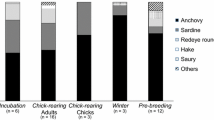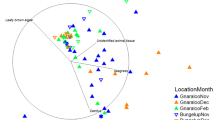Abstract
Some procellariiform seabirds use a dual strategy for provisioning their chicks by alternating short (ST) and long (LT) foraging trips. Parent birds gain mass during LT but they lose mass while increasing the chick feeding frequency during ST. Self-feeding during LT is crucial for the success of ST because firstly most of the energy used during ST is likely to be derived from the energy stored during LT and secondly self-feeding during ST is presumed to be negligible. Self-feeding by adult procellariiforms is thus a key issue to understand allocation processes but it is still poorly known. We tested these predictions by using the stable isotope (δ15N and δ13C) technique on birds’ plasma and prey with the short-tailed shearwater Puffinus tenuirostris breeding at Tasmania as a model. Parent shearwaters returning to the colony after a LT have an Antarctic/subantarctic δ13C signature in their plasma (−23.8‰), thus indicating that they fed in cold waters, far away from their breeding colony, for their own maintenance. Parent birds returning to the colony after a ST also have a distant Antarctic/subantarctic δ13C signature in their plasma (−24.3‰), thus verifying that self-feeding is negligible during ST and that birds fast at that time, using energy stores built up in cold waters. Plasma δ15N values of adults (8.8‰) indicates they mainly prey upon zooplankton-eating organisms, probably mesopelagic myctophid fishes. A simple isotopic mixing model estimates that they consume by mass 87% myctophids and 13% subantarctic krill when self-feeding. Finally and as expected, the carbon isotopic signature of chick plasma (−22.2‰) was intermediate between those of high- and low-latitude marine organisms and is thus in agreement with chicks being fed with a large diversity of prey species caught by adult birds from Antarctic to Tasmanian waters. One main consequence of this system is that reproduction of a Tasmanian species is controlled by resources available at great distances from the breeding colony that drive allocation decisions of parent birds.

Similar content being viewed by others
References
Altabet MA, François R (1994) Sedimentary nitrogen isotopic ratio as a recorder for surface ocean nitrate utilization. Global Biogeochem Cycles 8:103–116
Baker AC, Boden BP, Brinton E (1990) A practical guide to the euphausiids of the world. Natural History Museum Publications, London
Bearhop S, Teece MA, Waldron S, Furness RW (2000) Influence of lipid and uric acid on δ13C and δ15N values of avian blood: implications for trophic studies. Auk 117:504–507
Blackburn M (1980) Observations on the distribution of Nyctiphanes australis Sars (Crustacea, Euphausiidae) in Australian waters. CSIRO Division of Fisheries and Oceanography, Melbourne, Report, vol 119, pp 1–10
Catard A, Weimerskirch H, Cherel Y (2000) Exploitation of distant Antarctic waters and close shelf-break waters by white-chinned petrels rearing chicks. Mar Ecol Prog Ser 194:249–261
Chaurand T, Weimerskirch H (1994) The regular alternation of short and long foraging trips in the blue petrel Halobaena caerulea: a previously undescribed strategy of food provisioning in a pelagic seabird. J Anim Ecol 63:275–282
Cherel Y, Robin JP, Le Maho Y (1988) Physiology and biochemistry of long-term fasting in birds. Can J Zool 66:159–166
Cherel Y, Mauget R, Lacroix A, Gilles J (1994) Seasonal and fasting-related changes in circulating gonadal steroids and prolactin in king penguins Aptenodytes patagonicus. Physiol Zool 67:1154–1173
Cherel Y, Hobson KA, Weimerskirch H (2000) Using stable-isotope analysis of feathers to distinguish moulting and breeding origins of seabirds. Oecologia 122:155–162
Cherel Y, Bocher P, de Broyer C, and Hobson KA (2002a) Food and feeding ecology of the sympatric thin-billed Pachyptila belcheri and Antarctic P. desolata prions at Iles Kerguelen, Southern Indian Ocean. Mar Ecol Prog Ser 228:263–281
Cherel Y, Bocher P, Trouvé C, Weimerskirch H (2002b) Diet and feeding ecology of blue petrels Halobaena caerulea at Iles Kerguelen, Southern Indian Ocean. Mar Ecol Prog Ser 228:283–299
Cherel Y, Hobson KA, Hassani S (2005) Isotopic discrimination between food and blood and feathers of captive penguins: implications for dietary studies in the wild. Physiol Biochem Zool 78:106–115
Connan M, Mayzaud P, Boutoute M, Weimerskirch H, Cherel Y (2005) Lipid composition of stomach oil in a procellariiform seabird Puffinus tenuirostris: implications for food-web studies. Mar Ecol Prog Ser 290:277–290
Drent RH, Daan S (1980) The prudent parent: energetic adjustments in avian breeding. Ardea 68:225–252
Forero MG, Hobson KA (2003) Using stable isotopes of nitrogen and carbon to study seabird ecology: applications in the Mediterranean seabird community. Scientia Marina 67(Suppl 2):23–32
François R, Altabet MA, Goericke R (1993) Changes in the δ13C of surface water particulate matter across the subtropical convergence in the SW Indian Ocean. Global Biogeochem Cycles 7:627–644
Gauthier G, Bêty J, Hobson KA (2003) Are greater snow geese capital breeders? New evidence from a stable-isotope model. Ecology 84:3250–3264
Goericke R, Fry B (1994) Variations of marine plankton δ13C with latitude, temperature, and dissolved CO2 in the world ocean. Global Biogeochem Cycles 8:85–90
Goodman D (1974) Natural selection and a cost ceiling on reproductive effort. Am Nat 108:247–268
Hilderbrand GV, Farley SD, Robbins CT, Hanley TA, Titus K, Servheen C (1996) Use of stable isotopes to determine diets of living and extinct bears. Can J Zool 74:2080–2088
Hobson KA (1993) Trophic relationships among high Arctic seabirds: insights from tissue-dependent stable-isotope models. Mar Ecol Prog Ser 95:7–18
Hobson KA, Clark RG (1993) Turnover of 13C in cellular and plasma fractions of blood: implications for nondestructive sampling in avian dietary studies. Auk 110:638–641
Hobson KA, Alisauskas RT, Clark RG (1993) Stable-nitrogen isotope enrichment in avian tissues due to fasting and nutritional stress: implications for isotopic analyses of diet. Condor 95:388–394
Hobson KA, Piatt JF, Pitocchelli J (1994) Using stable isotopes to determine seabird trophic relationships. J Anim Ecol 63:786–798
Hodum PJ, Hobson KA (2000) Trophic relationships among Antarctic fulmarine petrels: insights into dietary overlap and chick provisioning strategies inferred from stable-isotope (δ15N and δ13C) analyses. Mar Ecol Prog Ser 198:273–281
Hunt GL, Baduini C, Jahncke J (2002) Diets of short-tailed shearwaters in the southeastern Bering Sea. Deep Sea Res 49:6147–6156
Kelly JF (2000) Stable isotopes of carbon and nitrogen in the study of avian and mammalian trophic ecology. Can J Zool 78:1–27
Klaassen M, Lindström A, Meltofte H, Piersma T (2001) Arctic waders are not capital breeders. Nature 413:794
Klomp NI, Schultz MA (2000) Short-tailed shearwaters breeding in Australia forage in Antarctic waters. Mar Ecol Prog Ser 194:307–310
Kock KH (1992) Antarctic fish and fisheries. Cambridge University Press, Cambridge
Lomakina NB (1966) The euphausiid fauna of the Antarctic and notal regions. In: Andriashev AP, Ushakov PV (eds) Biological reports of the Soviet Antarctic expedition 1955–58, volume 2. Israël Programme for Scientific Translations, Jerusalem, pp 260–342
Lourey MJ, Trull TW, Tilbrook B (2004) Sensitivity of δ13C of Southern Ocean suspended and sinking organic matter to temperature, nutrient utilization, and atmospheric CO2. Deep Sea Res I 51:281–305
McCutchan JH, Lewis WM, Kendall C, McGrath CC (2003) Variation in trophic shift for stable isotope ratios of carbon, nitrogen, and sulfur. Oikos 102:378–390
McNamara JM, Houston AI (1996) State-dependent life histories. Nature 380:215–221
Pakhomov EA, Perissinotto R, McQuaid CD (1996) Prey composition and daily rations of myctophid fishes in the Southern Ocean. Mar Ecol Prog Ser 134:1–14
Pinnegar JK, Polunin NVC (1999) Differential fractionation of δ13C and δ15N among fish tissues: implications for the study of trophic interactions. Funct Ecol 13:225–231
Raclot T, Groscolas R, Cherel Y (1998) Fatty acid evidence for the importance of myctophid fishes in the diet of king penguins, Aptenodytes patagonicus. Mar Biol 132:523–533
Rau GH, Sweeney RE, Kaplan IR (1982) Plankton 13C/12C ratio changes with latitude: differences between northern and southern oceans. Deep Sea Res 29:1035–1039
Rau GH, Hopkins TL, Torres JJ (1991) 15N/14N and 13C/12C in Weddell Sea invertebrates: implications for feeding diversity. Mar Ecol Prog Ser 77:1–6
Sabourenkov EN (1991) Mesopelagic fish of the Southern Ocean—summary results of recent Soviet studies. CCAMLR Sel Scient Pap 1990:433–457
Schmidt K, Atkinson A, Stübing D, McClelland JW, Montoya JP, Voss M (2003) Trophic relationships among Southern Ocean copepods and krill: some uses and limitations of a stable isotope approach. Limnol Oceanogr 48:277–289
Schmidt K, McClelland JW, Mente E, Montoya JP, Atkinson A, and Voss M (2004) Trophic-level interpretation based on δ15N values: implications of tissue-specific fractionation and amino acid composition. Mar Ecol Prog Ser 266:43–58
Schultz MA, Klomp NI (2000) Does the foraging strategy of adult short-tailed shearwaters cause obesity in their chicks? J Avian Biol 31:287–294
Smale MJ, Watson G, Hecht T (1995) Otolith atlas of Southern African marine fishes. Ichthyological monographs, volume 1. J.L.B. Smith Institute of Ichthyology, Grahamstown
Stearns SC (1992) The evolution of life history theory. Oxford University Press, Oxford
Terazaki M, Wada M (1986) Euphausiids collected from the Australian sector of the Southern Ocean during the Biomass SIBEX cruise (KH-83–4). Mem Natnl Instit Polar Res Spec Issue 40:97–109
Thompson DR, Phillips RA, Stewart FM, Waldron S (2000) Low δ13C signatures in pelagic seabirds: lipid ingestion as a potential source of 13C-depleted carbon in the Procellariiformes. Mar Ecol Prog Ser 208:265–271
Tieszen LL, Boutton TW, Tesdahl KG, Slade NA (1983) Fractionation and turnover of stable carbon isotopes in animal tissues: implications for δ13C analysis of diet. Oecologia 57:32–37
Vanderklift A, Ponsard S (2003) Sources of variation in consumer-diet δ15N enrichments: a meta-analysis. Oecologia 136:169–182
Wada E, Terazaki M, Kabaya Y, Nemoto T (1987) 15N and 13C abundances in the Antarctic Ocean with emphasis on the biogeochemical structure of the food web. Deep Sea Res 34:829–841
Weimerskirch H (1998) How can a pelagic seabird provision its chick when relying on a distant food resource? Cyclic attendance at the colony, foraging decision and body condition in sooty shearwaters. J Anim Ecol 67:99–109
Weimerskirch H (1999) The role of body condition on breeding and foraging decision in albatrosses and petrels. In: Adams NJ, Slotow RH (eds) Proceedings of the 22 international ornithological congress, Durban. BirdLife South Africa, Johannesburg, pp 1178–1189
Weimerskirch H (2002) Seabird demography and its relationship with the marine environment. In: Schreiber EA, Burger J (eds) Biology of marine birds. CRC Press, Boca Raton, pp 115–135
Weimerskirch H, Cherel Y (1998) Feeding ecology of short-tailed shearwaters: breeding in Tasmania and foraging in the Antarctic? Mar Ecol Prog Ser 167:261–274
Weimerskirch H, Chastel O, Ackermann L, Chaurand T, Cuénot-Chaillet F, Hindermeyer X, Judas J (1994) Alternate long and short foraging trips in pelagic seabird parents. Anim Behav 47:472–476
Weimerskirch H, Fradet G, Cherel Y (1999) Natural and experimental changes in chick provisioning in a long-lived seabird, the Antarctic prion. J Avian Biol 30:165–174
Weimerskirch H, Ancel A, Calouin M, Zahariev A, Spagiari J, Kersten M, Chastel O (2003) Foraging efficiency and adjustment of energy expenditure in a pelagic seabird provisioning its chick. J Anim Ecol 72:500–508
Wilkinson L (1999) SYSTAT 9 for Windows. SPSS, Chicago
Acknowledgements
The authors thank P. Borsa for his help in the field, P. Healy for preparing samples for stable isotope analysis and M. Stocki for running the samples at the Department of Soil Science, University of Saskatchewan. The study would have not been possible without the support of the Parks and Wildlife Service (N. Brothers, R. Gales and I. Skira). The study was conducted under permit no. FA96188 from the Animal Ethics Committee of the Tasmanian Parks and Wildlife Service.
Author information
Authors and Affiliations
Corresponding author
Additional information
Communicated by Roland Brandl
Rights and permissions
About this article
Cite this article
Cherel, Y., Hobson, K.A. & Weimerskirch, H. Using stable isotopes to study resource acquisition and allocation in procellariiform seabirds. Oecologia 145, 533–540 (2005). https://doi.org/10.1007/s00442-005-0156-7
Received:
Accepted:
Published:
Issue Date:
DOI: https://doi.org/10.1007/s00442-005-0156-7




